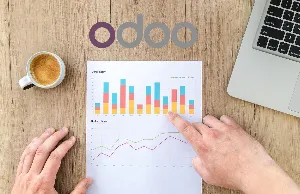At Bombora’s Second Annual Intent Event in September 2019, I noticed a unique trend among several successful B2B sales and marketing teams. Most of the presentations shared a common way of gathering, organizing, and perhaps most importantly, valuing all their sources and types of data.
I could easily make sense of how these teams were so successful in achieving their ultimate objective of business growth.
But wait for a second! You might have already started guessing their success strategy and if you have guessed ‘using data analytics tools,’ you are partially right.
Why partially?
It’s because using data analytics tools does boost your business growth but not completely. Using the right mixture of different types of analytics is key to experiencing everlasting success in business.
Through this article, I intend to draw your attention to the four types of data analytics, and how they benefit your business in a specific way. And that’s not it. Real use-cases will help you apply such data analytics strategies in your own business ventures and grow at a faster, steady pace.
Before we get into this, let me tell you something about an emerging yet profitable data analytics model called Managed Analytics-as-a-Service (MAaaS).
MAaaS: Accelerate Business Growth Exponentially
You can pick any data analytics solution in the current market. All are meant to accelerate your business growth.
So why am I bringing MAaaS into the limelight?
Well, it can guarantee you a 1200% return on investment (ROI) with a lower total cost of ownership. Data automation, self-service BI capabilities, and data cleansing are some of its striking features.
I and my team at Brainvire have achieved significant breakthroughs in the SaaS-based data analytics domain. We’ve built over 150 customized reporting formats for different applications and delivered tailored insights into the most pressing problems related to product profitability, customer experience, supply chain and much more.
Managed Analytics Leads You From Automation to Orchestration
Marketing automation, based on real-time data insights, is a good thing. But, that’s not enough for a business to succeed. I feel that the data should be orchestrated in the correct manner.
Several influential B2B marketers have recently written about this shift from automation to orchestration. Marc Johnson, CMO at Bombora, said: “Orchestration means moving away from automating single tools and components, toward having all of the different marketing and sales elements running off of the same data and talking to each other. It’s about actually aligning around what the consumer needs and what the prospect is interested in.”
Elaborating on the same shortfalls of automation, Scott Vaughan, CGO at Integrate, recently wrote in B2B Marketing Shifts from Automation to Orchestration: “The overabundance of disconnected tech and tools to automate key processes is often creating more work than it’s worth to implement and use. Orchestration builds off basic automation and offers the ability to orchestrate data, systems, programs, and experiences and adds new levels of intelligence.”
And as the sources and types of data we use to drive our increasingly sophisticated initiatives proliferate (not to mention the growing number of data-privacy regulations), we must orchestrate this data accordingly.
Data orchestration would require all four types of analytics to come together and show their prowess. So let’s explore them in detail one by one.
4 Types of Data Analytics
Descriptive Analytics
Descriptive analytics is the backbone of reporting; you will never come across any BI tools and dashboards without it. It answers your basic how many, when, where, and what questions.
We can classify descriptive analytics into two categories:
- Adhoc Reporting
- Canned Reports
A canned report is one that has been designed previously and contains information around a given subject. An example of this is a monthly report sent by your ad agency or ad team that details the performance metrics of your latest ad campaigns.
The Adhoc report, on the other hand, is designed by you and usually aren’t scheduled but are more in-the-moment. They’re useful for obtaining more in-depth information about a specific query. An ad hoc report you might run could be on your social media profile looking at the types of people who’ve liked your page along with what other pages in your industry they’ve liked. Its hyper specificity helps give a fuller picture of your social media audience, and chances are you won’t need to view this type of report a second time (unless there’s a major change to your audience).
Moving further, let’s see how descriptive analytics can escalate the growth of the cosmetics industry.
Descriptive Analytics Delivers Value in the Cosmetics Industry
In the cosmetics industry, growth is driven by the confluence of consumer expectations for products tailored to their specific needs and characteristics.
To address such expectations, industry leaders must be able to drive rapid innovation and get new products to market quickly. However, this is easier said than done. One solution is to find opportunities to use long-popular components, such as aloe, in new ways and develop new formulations to provide refreshed product offerings with reliable benefits.
Aloe has remained one of the most popular natural products for cosmetic use for decades due to its attractive properties and relatively low cost to the process. With so many existing products utilizing aloe, it can be hard for cosmetics companies to find any IP (Intellectual Property) runway to introduce new product formulations containing this attractive ingredient. In fact, our analysis shows that hundreds of other substances have already appeared in published patent applications with aloe. Analysis of CAS roles indexing, which describes the specific uses of a substance in each patent, shows that the primary function of aloe in these formulations is as a skin conditioner. Other top aloe-containing formulations have anti-aging and sunscreen applications.
As novel formulations are generally patentable globally, a possible strategy to innovate in this crowded space is to focus on using Aloe in less common applications or in formulations with less common components where there may be more IP whitespace. Descriptive analytics allow pharma companies to rapidly overview the various formulation components and intended uses to identify these areas of opportunity.
Moreover, companies can explore regional markets and the preferences of native people when it comes to experimenting with new formulations. An example of such an analysis is shown in the image below.
Diagnostic Analytics
As a user of this analytic type, I can get the answer to why something happened or what went wrong in my business.
For example, if I assume the role of a retailer then I can drill the sales and gross profit down to categories and find out why they missed their net profit target.
And suppose I work in the R & D department of a major healthcare company, I can perform customer segmentation after applying several filters like diagnoses and prescribed medications. This will allow me to identify the influence of medications.
Now, let me highlight the functions of diagnostic analytics, which fall broadly into three categories:
- Identify anomalies: Based on the results of the diagnostic analysis, analysts must identify areas that require further study simply by looking at the data. These could include questions like why sales have increased in a region where there was no change in marketing, or why there was a sudden change in traffic to a website without an obvious cause.
- Drill into the analytics (discovery): Analysts must identify the data sources that will help them explain these anomalies. Often, this step requires analysts to look for patterns outside the existing data sets, and it might require pulling in data from external sources to identify correlations and determine if any of them are causal in nature.
- Determine causal relationships: Hidden relationships are uncovered by looking at events that might have resulted in the identified anomalies. Probability theory, regression analysis, filtering, and time-series data analytics can all be useful for uncovering hidden stories in the data.
Read one of Brainvire’s case studies below to visualize diagnostic analytics in action in the healthcare industry.
HIPAA-Compliant Solution Successfully Processes Over 4 Million Medical Records on AWS Servers
Our diagnostic analytics solution for a prominent name in the American healthcare industry streamlined healthcare data interoperability services. The confidential medical data of patients can be seamlessly analyzed by a team of medical specialists and insurance service providers. They can then tailor medical therapies to suit the patients’ requirements.
Thus, diagnostic analytics gives in-depth insights into a particular problem. At the same time, a company should have detailed information at their disposal. Otherwise, end-users won’t be able to see the real benefits of such solutions.
Predictive Analytics
As the name suggests, predictive analytics tells us what is likely to happen. It uses the findings of descriptive and diagnostic analytics to detect clusters and exceptions and to predict future trends. This makes it a valuable tool for forecasting.
The category can be further broken down into predictive modeling and statistical modeling. But, these two are generally used together.
Assume you are running an advertising campaign on Facebook. Statistical modeling will determine how closely the conversion rate correlates with a target audience’s geographic area, income bracket, and interests. After that, predictive modeling can be used to analyze the statistics for two (or more) different target audiences and provide you with possible revenue values for each demographic.
From an IT innovator’s perspective, predictive analytics can do much more than just analyzing digital marketing campaigns. So let me tell you something interesting.
| 39% Surge in Urban Vehicle Parking Revenues After Using Predictive Analytics in a Smart Vehicle Parking Application. Yes, this is possible when predictive analytics is coupled with an IoT application. The mobile app has improved the revenue of parking space providers in Kuwait and ensured the optimal utilization of such spaces. As soon as the users’ vehicle comes in the vicinity of a parking space, the predictive analytics algorithms can predict the availability of these slots in advance and relay the same to the user. Moreover, they will check if the parking space can accommodate a vehicle with larger dimensions. |
Prescriptive Analytics
Do you give it a thought when your Uber driver gets the easier route from Google Maps? I bet on it that most of you would never question such day-to-day conveniences.
Well, prescriptive analytics was working behind the scenes so that you reach your destination quickly. The best route was chosen by considering the distance of every available route from your pick-up route to the destination and the traffic constraints on each road.
This is a simple use case that offers clarity on the purpose of prescriptive analytics i.e. what action to take to eliminate a future problem or take full advantage of a promising trend.
Oil and Gas is an industry that requires a more complex analytic approach.
Strategy and Enterprise Optimization in the Oil & Gas Industry
In Oil & Gas, prescriptive analytics plays a crucial role in modeling the key inputs, asset base, supply chain, demand and financials to improve the design and on-going operations.
- Design is improved by understanding which assets to own, in which locations and what type of equipment. For example, how much capacity will be optimal? The use of stochastic optimization enables the model to optimize decisions under uncertainty, and by enabling Monte-Carlo simulation, users can evaluate the range of events under which the decisions still meet corporate objectives.
- On-going operational planning is optimized by making holistic decisions. For example, companies can decide which products they should make based on existing contracts, forecasted prices, and inventory on hand.
Applications of prescriptive analytics like these have proven to be valuable for resource-based organizations, unlocking substantial benefits. For instance, a large company experienced a 4% boost in revenue and a significant reduction in decision-making time, from weeks to just a few hours. Numerous success stories and use cases similar to this one can be readily found across the internet. As a trusted Microsoft partner, we focus on delivering these tangible improvements to enhance your organization’s performance.
Before winding up this section, I would like to tell you that implementing and managing prescriptive analytics isn’t that easy. It involves the use of sophisticated algorithms and technologies, including Machine Learning. Take a look at the image below and you will know for yourself.
A tech firm that offers Power BI consulting services would help you in the overall implementation process.
Summing it Up
No matter what size of business you own, never rely on my gut feeling or a single analytics method to make business decisions. Always use a mix of different types of analytics tools to arrive at a logical decision. It will go a long way in helping you overcome some of the greatest business challenges. Brainvire always believes data is equivalent to gold for any business and you need advanced tools to mine it into something valuable. Good luck!
Related Articles
-
How to Drive Success Leveraging Odoo ERP, Business Intelligence, and Data Analytics
Data analysis has become central to determining the best decision-making. But today, companies need an automated system to organize data at scale. ERP and BI are integrated and can be
-
Looking for Data Visualization? Switch to Microsoft PowerBI
Being an enterprise you ought to have MIS reports and other related graphs on your table before conducting or attending any board meeting. Within a span of a year, Graphical
-
The Clash of Analysis Titans- Power BI Reports VS Dashboards
Power BI is a Microsoft tool that empowers businesses to share business insights within the company. This advanced tool can help to collect, crunch, and analyze data in the best



